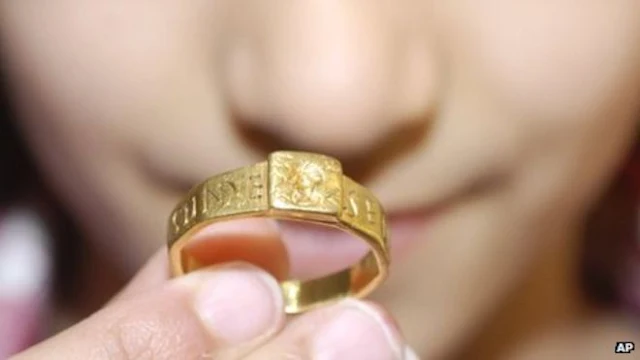The Vyne Ring or the Ring of Silvianus is a gold ring, dating probably from the 4th century, discovered in a ploughed field near Silchester, in Hampshire, England, in 1785. Originally the property of a British Roman called Silvianus, it was apparently stolen by a person named Senicianus, upon whom Silvianus called down a curse.
After its discovery in the 18th century, the ring became the property of the Chute family, whose country house was The Vyne, also in Hampshire, now a National Trust property. The ring went on display there in April 2013.
In 1929, during excavations of the site of the Roman temple of Nodens at Lydney Park, the archaeologist Sir Mortimer Wheeler discovered details of the curse. As Wheeler consulted with J. R. R. Tolkien on the name of the god invoked in the curse, the ring and curse may have inspired the One Ring in The Hobbit and The Lord of the Rings
The Ring of Silvianus is larger than most rings, being 25 mm (1 in) in diameter and weighing 12 g (0.4 oz), and was perhaps intended to be worn over a glove
The band of the ring has ten facets. It is set with a square bezel engraved with an image of the goddess Venus.
To one side are the letters "VE" and to the other side "NVS", in mirror writing. When used as a signet ring to make a seal, the head and script would be raised, and the letters would appear the right way around.
The band is inscribed with the words "SENICIANE VIVAS IIN DE". This contains two errors as the "I" has been doubled, leaving no room for the last letter "O". The inscription should have finished "VIVAS IN DEO" — a common inscription for Roman Christians, meaning "live in God"
The band of the ring has ten facets. It is set with a square bezel engraved with an image of the goddess Venus. To one side are the letters "VE" and to the other side "NVS", in mirror writing. When used as a signet ring to make a seal, the head and script would be raised, and the letters would appear the right way around.
The band is inscribed with the words "SENICIANE VIVAS IIN DE". This contains two errors as the "I" has been doubled, leaving no room for the last letter "O". The inscription should have finished "VIVAS IN DEO" — a common inscription for Roman Christians, meaning "live in God"
The ring connects to Tolkien through another archaeological site, Lydney in Gloucestershire, commonly known as "Dwarf's Hill." There, a tablet tells of the curse on Senicianus' ring. According to the tablet, a man named Silvianus tells an obscure deity called Nodens that Senicianus stole his ring. The tablet lays a curse on any bearing the name Senicianus until the thief returns the ring to Nodens' temple.
In 1929, Tolkien was a professor of Anglo-Saxon at Oxford, and archaeologist Sir Mortimer Wheeler—who connected the tablet with the ring—asked Tolkien to advise him on the name of the god in question. The ring has long languished in obscurity, but now the Vyne is highlighting it, displaying it alongside memorabilia from the Tolkien Society.























0 comments